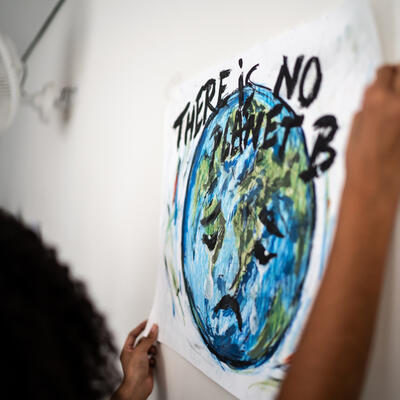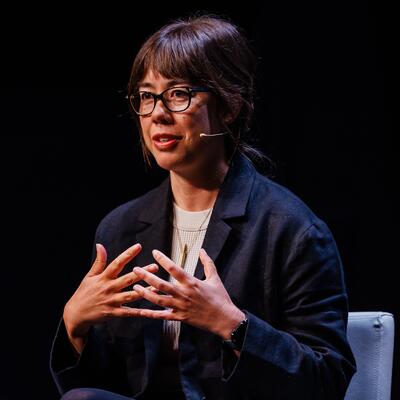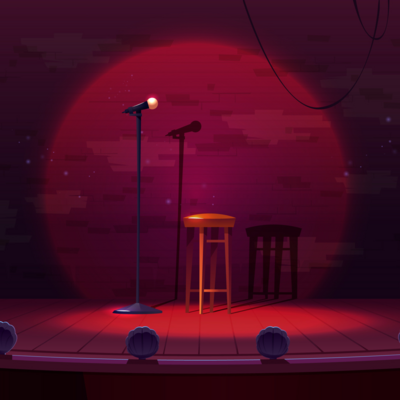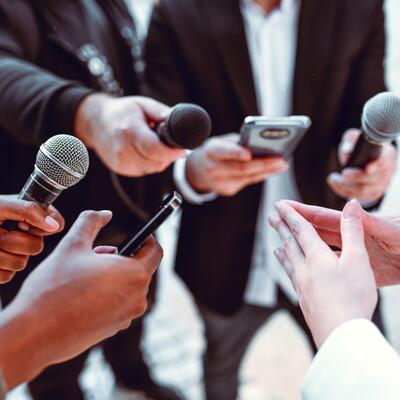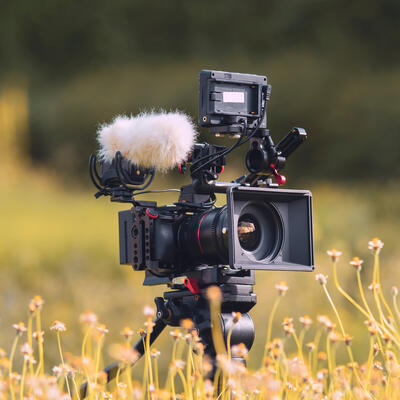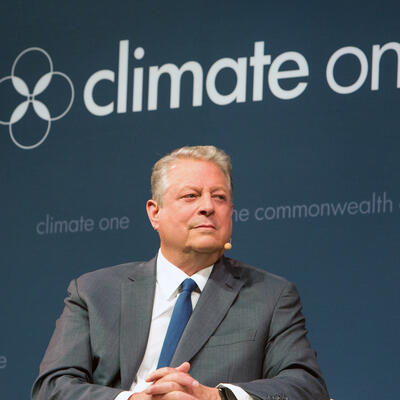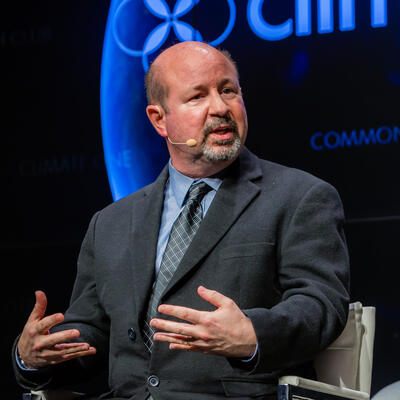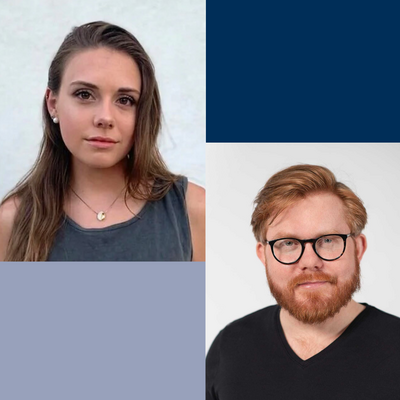
Taylor Brorby and Suzie Hicks Tell The Stories We Don’t Always Hear
Guests
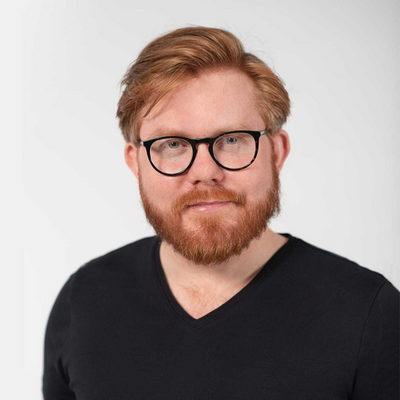
Taylor Brorby
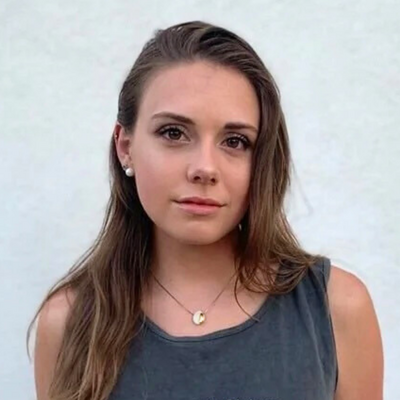
Suzie Hicks
Summary
Finding one's voice in climate action can come in many forms. Author and activist Taylor Brorby grew up in Center, North Dakota as a fourth-generation member of a fossil-fuel family. He struggled to find his place as a young gay kid who loved art, music, nature and poetry. Over time, he turned that tension into writing that challenges the fossil fuel industry, makes space for others stuck in a broken system, and inspires a more just future.
“I go where other writers fear to tread because I know queer people exist. That we are everywhere and we need to know we are not alone and that our stories matter,” Brorby says. “I think a book like mine, hopefully for anyone who's struggling, can see a way of existing in the world and trying to be who you are, despite the circumstances.”
Suzie Hicks felt the weight of climate concerns but after college, didn’t know what to do with those feelings. After doing an internship at the New England Aquarium, they realized they could merge their love of performing with a career focused on climate. With the help of a sunflower puppet named Sprout, Suzie created a children’s show that teaches kids about climate change through a frame of possibility and hope, not doom and gloom.
For Hicks, the show is somewhat of a welcome committee for kids into the climate subject. They explain some of the questions the show might answer for its young viewers: “ ‘Why is all of this happening? How is it affecting us?’ But then also, ‘How are we gonna do something about it?’ And most importantly, [the show tells them] it's okay to be scared. And it's okay to be sad and it's okay to be angry and let's feel those feelings together.”
Hicks says positive stories and framing are essential to helping kids and adults make sense of the current moment.
“My job as an educator and as a storyteller is to say: There are good things happening, even though the dominant narrative right now is, ‘everything is bad.’ Here are the bright spots and the more bright spots we have, the brighter everything gets.”
Episode Highlights
00:30 – New York Climate Week recap
02:20 – Taylor Brorby describes the N.D. town where he grew up
05:00 – What he learned from the prairie landscape
07:30 – Other queer writers from the Great Plains
13:30 – Influential environmental writers
17:00 – Writing optimistically rather than dystopian narratives
20:00 – Getting arrested protesting the Dakota Access Pipeline
25:30 – Why we need to be supporting rural writers
30:00 – Project Tundra, a carbon capture project near Center, N.D.
34:00 – Origins of Suzie Hicks, the Climate Chick
36:30 – It’s okay to have complicated feelings about climate change
40:00 – Working with kid’s existing love for nature in educating them about climate change
42:00 – Why introduce kids to climate change? Because it’s already happening.
47:00 – How Hicks sees her role as a positive storyteller around climate change
52:00 – Climate One More Thing
Resources From This Episode (2)
Full Transcript
Note: Transcripts are generated using a combination of automated software and human transcribers and may contain errors. Please check the actual audio before quoting it.
Ariana Brocious: I’m Ariana Brocious.
Kousha Navidar: I’m Kousha Navidar.
Ariana Brocious: And this is Climate One.
Ariana Brocious: Kousha, you were just at New York Climate Week with our colleague Austin Colón. How was it?
Kousha Navidar: Busy! Imagine hundreds of events across all five boroughs, so I only made it to a handful. I rode the cross town bus QUITE A BIT..
Ariana Brocious: Yeah, sounds hectic! What were your top takeaways?
Kousha Navidar: Well, Austin and I debriefed a little at Central Park – we both attended interesting sessions: like battery storage and greening public schools, as well as this youth demonstration at Central Park. But I was also keen to get a feel for the timbre of conversations – whether there was optimism, realism, or both.
Ariana Brocious: And what’d you find?
Kousha Navidar: Yeah, I did feel optimism. There was a lot of talk about normalizing our new climate reality and solutions that exist. The other takeaway that I thought was super interesting was there was direct talk about the emotions we had at our disposal to confront problems. One panelist said, there's a lot of energy around this space right now, and a lot of emotions including anger and rightfully so, But we have so many other emotions to appeal to people to discuss. These issues. And that includes laughter and it includes joy. And that for me flows right into this week’s conversations, which are pretty inspiring.
Ariana Brocious: Absolutely. Finding one's voice in climate action can come in many forms. And while New York City may be the center of the universe, at least for some,
Kousha Navidar: Hey, shots fired.
Ariana Brocious:… we’re going to start this next conversation in the middle of the country, in a place aptly called Center, North Dakota. That’s where author and activist Taylor Brorby grew up. As a 4th generation member of a fossil-fuel family, he struggled to find his place as a young gay kid who loved art, music, nature, and poetry. Over time, he channeled that tension into writing and activism. His novel, “Boys and Oil: Growing Up Gay in a Fractured Land” was published in 2022.
Taylor Brorby: Well center seems to be the middle of nowhere other than the center of my imagination. It's sort of a hubristically named town. I mean, the interstate doesn't even go through Center. Center has one stop sign. There's not even a stoplight in the county. It's the only incorporated town. So when I was little, it would take me fewer than 10 minutes to bike from one end of town to the other. And you know, the only sort of notable thing is the large drag line clawing away at the earth for strip mining lignite coal. And when I look back at it. No one talked like this, but it's very clear to me. I grew up in a company town. Everybody was connected to that industry, and even so much that even in our recreation, the first hole of the Square Butte Creek golf course tees up as if you're hitting towards the power plant where my mother spent the entirety of her career. So even in your recreation, it's like a postmodern volcano god, like you will worship it. And at the base of that power plant is also the only lake in North Dakota that never freezes. Just a gentle reminder, every lake in North Dakota should freeze, but if you and I went back for a little vacay in January. We could sit in that Lake Nelson Lake with stocking caps on and it would be bathtub warm, and that's from the water being used to cool the coal-fired turbine engines of that power plant. But beyond that industry, what growing up in Center really gave me was the wide world, the big, beautiful world.
I mean, the Square Butte Creek was my babysitter in the afternoon. I could go fishing there all day. It was beyond the wheat field, beyond the backyard of my house, and that's a great landscape for your imagination to run wild simultaneously. It can also be a lonely place if you don't quite fit in as well.
Ariana Brocious: Yeah, so I spent five years living on the Great Plains and it took me a little while, but over time I developed a really deep appreciation for the landscape. And your writing about the land is so evocative and it really captures the complexity, the nuance, this sort of multi-layered kind of landscape that is the Great Plains. So I'm curious for you what growing up on the prairie and staring at these beautifully expansive landscapes taught you?
Taylor Brorby: I think those landscapes taught me patience that in American culture, we're so consumed by height. We want the tallest skyscrapers. You know, people who think they're ambitious, go mountain climbing or go mountain hiking. Height doesn't really impress me. I mean, I'm a five foot six on a good day, little Viking. I am very intrigued by expansiveness and very few people I've met have literally traversed the Great Plains. You know, people will say, oh, I'm hiking Mount Shasta or going to Mount Rainier this weekend, whoop dee do, walk across my prairie and get back to me. It takes longer than a weekend. And I think too, like the late Minnesota writer Paul Gruchow said, part of what the prairie teaches us is that we have to get on our knees, like we have to submit to it. And so it's also why it's a place that is so difficult to fully destroy. Unlike mountains, which we blow up from mount top removal, mining, or forests, which we clear cut. I mean, we have tried to clear cut the prairie to grow American crystal sugar. We've tried to plunge it from fracking. We've tried to scrape it through lignite coal mining. We've even plunged it with nuclear warheads in the northern tier of North Dakota. But that prairie teaches you, it's one of the most diverse bio regions. And so what that taught me is that to thrive nature reveals that we need diversity. We need diversity in our ecosystems. We probably need diversity in our human thinking systems as well. And so growing up there taught me we thrive when we're in diverse landscapes, in varied conversations. When more people are at the table that look different from us than similar to us.
Ariana Brocious: Yes. Yeah. There aren't that many books that explore rural life in the way yours does. Your book, “Boys and Oil, Growing up Gay in a Fractured Land.” So, how do you see your work speaking to this idea of diversity? You know, expanding our understanding of who belongs in a place like North Dakota.
Taylor Brorby: There are some other books that paved the way for me. I mean, we can go all the way back to I, I mean, my whole mission is to make the Great Plains gay again, you know, and someone has to take on Great Aunt Willa Cather. You know, she's been dead for a hot minute, but even in my home state, we've sort of produced an inordinate amount of writers who are queer. Ahead of me is Melanie Hoffer, who wrote a great book called Prairie Silence, as well about some similar concepts, more of realizing she's gay and a middle school sort of romance that ignited that. But I do think you're right. That rare are the books that bring together ecological thinking or environmentalism and queerness. And when I am on my dog and pony shows around the country, and I'll say, well, name a famous piece of literature from the American West or Great Plains about being gay. Everybody quickly says that 28 page short story Broke Back Mountain by Annie Pru. Beautifully written. It's a horror story. If you're someone like me, I mean, one of the characters gets murdered in there and I think it's so bottom of the barrel to say it, but true. We needed a nonfiction book and we need more of these books where the gay kid lives, where the trans kid lives. You know my book should not be unique in that landscape. We're talking about a huge swath of the country. I mean I do not, I do not go to the 92nd Street Y. I rarely speak in San Francisco. I go to sexy places like Billings, Montana, you know, or Brigham Young University. I go where other writers fear to tread because I know queer people exist. There we are everywhere and we need to know we are not alone and that our stories matter. And so I think a book like mine, hopefully for anyone who's struggling, can see maybe not an exact path forward, but a way of existing in the world and trying to be who you are despite the circumstances.
Ariana Brocious: Yeah. Right. You were told by your first editor to quote, remove the gay thread from the book, and instead you removed the editor. I'm curious what it took for you to reclaim and fully inhabit your voice in this book.
Taylor Brorby: Oh, that was, that was a very dark period, to be honest. The first press that this book was under, , contract for, I was under contract for about four years before I finally got an agent. And I'd broken boys in oil into two books. One that I called the North Dakota book, more geologic landscape writing. Like a book by an author, I really admire, Gretel Erlic, the solace of Open Spaces. And then I was also writing what I was calling the gay book, which was kind of completely the human story of my existence on the side. But I thought anytime I was in the landscape in the North Dakota book, I thought, oh, that should be in the gay book. So it was this like psychic break in my mind of being not only thrust back into the closet that I'd worked so hard to get out of. But to then also think well. Why, why, why can't a gay man be in the landscape in the American West? Like we need that story too. It's not just growing up gay in a rural part of the world. It's literally, I love the natural world and rarely do we often think of rural spaces or national parks or public lands as overtly safe for queer people either. I needed this book. I mean, I'm a college professor. You need a book to have not only a tenure track job, but also I'm a type one diabetic. I need health insurance. And I was trying to do this book justice and get it out there, but it wasn't moving at the pace I needed it to move. I wasn't getting edited in a timely manner. I wasn't given direction. I mean, the edits I kept getting back were start over.
Ariana Brocious: Wow.
Taylor Brorby: It would be 450 pages. Start over. The book would be 222 pages. I'd try something, start over. You know, I got to a place where I literally thought I don't know how to spin a sentence, and then I gave a keynote address in 2019 for the North American Review, the nation's oldest literary journal. I gave a lecture where I had written it out and I didn't have anyone look it over 'cause I wanted to test myself to see can I do this? And when I got an instant standing ovation, I thought, something's wrong in the state of Denmark, and it's not my sentences, you know? And I got rid of that editor, you know, because it was the exact wrong editor for me. And, but it was years of my life, you know? I mean, I tried my best and sometimes you just have to part ways because people can't do what you need them to, or are in fact holding you back.
Ariana Brocious: Well bravo for taking that step 'cause it sounds excruciating.
Taylor Brorby: It was honestly, I mean, I don't wanna be rosy about it. You know, sometimes people see a book and they go, oh, how lucky are you? And it's like, let me tell you how much I suffered. You know, I had to change presses. And then it turns out when you do get an editor who's gay, that makes a world of difference. So that was nice.
Ariana Brocious: Yes. Representation in all places. There's a point in your book when you quote David Orr from his book, Earth in Mind, and I'm gonna read this quote quickly. “The plain fact is that the planet does not need more successful people, but it does desperately need more peacemakers, healers, restores, storytellers and lovers of every kind. It needs people who live well in their places. It needs people of moral courage, willing to join the fight to make the world habitable and humane.” I love that quote. I think it's so powerful. You talk a lot in the book about your path as a writer, discovering a lot of different literature in high school and in college. So how did reading that kind of work shape your path in becoming a storyteller?
Taylor Brorby: Oh my God. I mean reading David Orr, or like I had mentioned, Paul Gruchow, or even Louise Erdrich, perhaps the most well-known writer from my home state, winner of the National Book Award and the Pulitzer Prize. But David in particular, I grew up in a house without very many books. I mean, my mother read Mary Higgins Clark and my sister read Stephen King, but it's not like we had John Steinbeck on the shelves or Shakespeare or poetry of Auden. And if I was caught with a book and I used that word intentionally, my parents would say, go and do something. Reading was not viewed as doing anything. You know, if I was obsessively drawing Jafar on my sketch pad because I wanted to be a Disney animator. They thought that was doing something, or if I was practicing the piano that was doing something, but reading signaled to them leisure, too much free time, not enough activity, and little boys should be active. So they sent me into the big world beyond our backyard and the choke cherry trees and you know, the monarch butterflies and great blue herons. And so they gave me nature. As a gift, which I am grateful for it, and what college gave me was that wonderful thing called storytelling and writing, and that you could take the knowledge you had gleaned from your experiences in nature and render it in stories. And Earth in Mind, still, is such a revolutionary text when we think about how education should fit into the needs of the planet so that it doesn't exhaust our resources, that we need economies where we flourish rather than deplete. And I love that. You know, we need, I can get quite moved thinking about this, people with moral courage to stand up and we are in desperate need of that right now of stories that are creative and just, and you know, as my late teacher, Jim Farrell, who was good friends with David or would say, you know, a environmentalism can't be all doom and gloom. It needs to be fun and creative and sexy, and it needs to taste good. And that's a world I wanna reach out towards rather than one based in fear and scarcity. And so someone like David, his work has been bedrock and firing me up to say I wanna be on the side of the good. I wanna advocate and inspire and get more people in this jacuzzi because the water's fine. You know, it's a good time.
Ariana Brocious: We've talked on this show before about different kinds of writing around climate. You know, there's a tendency to go into dystopian types of future. There's a lot of writing in that vein. And also there's sort of a newer project coming out of Grist, which is speculative future and it's climate fiction. It's intended to kind of imagine futures that we could have. And your work is nonfiction. Let's make that clear. But I think there is power in imagination too. And you know, I'm, I'm kind of curious your thoughts on that type of writing.
Taylor Brorby: Yeah, well, I'm definitely one who reaches out more for what's possible and what's exciting rather than the dystopian future. That's not one that I look forward to, even if that is the future we're moving toward. But you know, the history of writing in the English language would reveal that we've always thought it's the end of the world. I mean, read Cotton Mathers’ sermons, you know, back in the 17th century, we're all going to hell and it's over. Well, somehow the 21st century has still shown up, you know? I think those mental stretches that Grist is asking writers to think about and contemplate, do demand something of us. I think it's far easier to imagine a totally denuded world, one of destruction than it is to think of the possibilities, especially if they're not purely technological as my friend Wendell Berry would say, we can't use the same methods that got us into this pickle to get us out. You know, we're not gonna frack our way into a better future. For instance, though, that's my second favorite F word, you know? But we need some writing that isn't necessarily overtly rosy or through rose tinted glasses, but actually maybe gets us to glance at the far horizon. And that's what, to your earlier question, growing up on the prairie, I got used to staring off into long distances and think, how do I get there? And we need more writers to take up that mantle to say, here are ways. And I think it's far more easy, I think, to reveal a world like what the movie Wall-E showed us, which increasingly might feel like it's coming to pass, you know? But I still like to believe there is time to resist and change. And if humans have made the world this way, we can make it a different way if only we have the willpower.
Kousha Navidar: Coming up, Taylor Brorby on the rise in library censorship and how it’s connected to silencing climate science.
Taylor Brorby: So we need those great books of science to show us what we know, what we don't yet know, what we need to know to live better on this planet and to certain economic interests and powerful people, that knowledge is threatening.
Kousha Navidar: That’s up next, when Climate One continues.
Ariana Brocious: This is Climate One. I’m Ariana Brocious. Let's get back to my conversation with author and activist, Taylor Brorby.
Ariana Brocious: In 2016, you were arrested as part of the Dirty 30 during a protest against the Dakota Access Pipeline.
Before that, you were already touring colleges. Speaking about your experience in oil boom towns, and you write about this in the book, but can you share what made you think that you really had to take another step that you needed to physically put your body on the line in this moment?
Taylor Brorby: Well, I, I had lived in the Balkan oil boom in the summer of 2014 and the previous November, Deb Marquardt my friend, and former teacher who teaches at Iowa State University, she and I, before I was a student there, taught creative writing in the Balkan oil boom and traveled about 6,000 miles in three weeks or so, and I went to Iowa State to get my masters in fine arts and creative writing in the environment and study with Deb. She's probably the most prominent North Dakota writer who also teaches, and I thought she'll get what I'm up to and has seen some of the same things. So I thought, I'm gonna move about 900 miles away from this oil boom. Great distance, you know, to have perspective. The first semester I arrive in town, the country's then largest oil pipeline is announced. The Dakota Access Pipeline could be cutting through the very county where I'm living, and I just took it upon myself I thought. I need to start traveling around Iowa. These farmers don't know what Balkan oil does to soil and stuff and, and what benzene is this known cancer causing agent. And all pipelines eventually leak. And I just thought, you know, I need to kind of help out and whip up a fury. And once that pipeline was announced, grad students and other community members had launched the Balkan Oil Pipeline Resistance Coalition, which I had joined on and started writing op-eds and all these different things. In 2016 I had a large anthology of creative writing called fracture, essays, poems, and fracking in America with some of our most prominent environmental thinkers like Bill McKibben or Kathleen D. Moore. Rick Bass come out because we had contributors from 26 different states and I wanted to show how widespread fracking was. Again, a book is a very non-violent form of protest and informing people, and I thought, we need. Art to show like we need poems, we need short stories, we need nonfiction pieces by people from where they live to help sound the alarm about this.
And none of it was working. You know, none of it was stopping this pipeline from being developed. I went back home to go the protest at Standing Rock for a few days when it was smaller, about 600 people. That was also a very informative experience for me. It's one of the first times. Where I was a visible minority as a white person and really listened and took in information and tried to build, you know, connections of saying, we're battling this in Iowa. What resources do we need to share? How do we frame different narratives that this isn't only about water rights in North Dakota, it's also about soil in Iowa and a climate future and all these. Things. Now I'm gonna get a little weepy. Forgive me, but in 2016, a Duke University study confirmed that my home, river, the Missouri River, was in fact radioactive.
Ariana Brocious: Hmm.
Taylor Brorby: And the Missouri River is the main artery of my imagination. I mean, where we launched our. Boat to go fishing in childhood. I was just convinced this is where Lewis and Clark met Sacajawea, one of the most important meetings in this country's history of westward expansion. Of course, and I knew I was growing up in this landscape of incredible stories, but when that study came out, my four nephews also depend on the Missouri River as do 10 million other people for their drinking water.
I was in my late twenties then, and when I knew there was going to be this action, I just wanted to do something that when my. Nephews are my age that when they asked me, uncle Taylor, why didn't you do everything you could to stop this? I wanted to have a better answer than I don't know. Now, being arrested is a very dangerous thing. I would not recommend it to other people. And it is about the loneliest I have ever felt in my life when I was no longer in charge of my body. I don't think I have more chutzpah or more bravery than anyone. It is really an isolating experience to be arrested and to know that, you know, you are really putting your body where your beliefs are and, and I wanted to be able for me to look in the mirror and face myself and say, okay, I did it. You know, I, I did that thing. And if I can be brave in that way, I can be brave in other ways.
Ariana Brocious: Hmm. So you grew up in a region deeply tied to the fossil fuel economy. A, a company town, as you say, you yourself benefited from that extraction. Your parents were working in that industry, but you've also become a really powerful advocate for environmental awareness. And I think we need more voices that have that complexity that yours embodies where you come from a region, you know it, and you also can then step outside of it and look at it. So I'm curious how you view your role in that way.
Taylor Brorby: I, I was taught that in Lutheran Sunday School, you know, from the Gospel of Luke, to whom much is given, much is expected, you know, and name a famous North Dakota writer. You know, it's usually a long silence there. I mean, there's Aunt Louise and then there's like. You know, big brother Chuck Klosterman, but he doesn't really write that much about North Dakota anymore.
And then, you know, the list gets mighty shorts. So in some ways I'm so glad I don't live in Brooklyn where I have to compete with all these other people. I've got a big empty bookshelf I need to fill and one that explores history. Um, the history of the region I was not taught North Dakota is kind of like my baby brother. I feel like I get to pick on him all the time, but no one else really gets to though. It's a complicated thing. We need to be supporting rural writers in their places because they understand the nuance of that place and the stories that need to be told. The history of North Dakota is the history of extraction.
I mean, it certifiably begins with French fur trappers. Then continues on with Lewis and Clark and everything. In the wake of that, it's where George Armstrong last lived before he went west and had the worst day of his life. It's where, you know, general Sully unleashed his howitzers on the Nakota, Dakota and Lakota people.
It's where sitting Bulls surrendered his rifle. Something I was never taught, which is basically the bending and the subjugation of the Native Nations to the US government, and I think. Coming from that place, it reveals that North Dakota has historically been the testing grounds for the country's worst ideas. Hydraulic fracking, nuclear warheads, , the clear cutting of the Red River Valley to grow Pepsi and candy corn that is sugar, you know, coal strip mining and now library censorship as well. So it's, it's this vast landscape where it's not only. Physical products, , resources from the ground.
It's also now the landscapes of our imagination that free market economics is coming after in that place.
Ariana Brocious: Yeah, I wanna talk about that because, , climate science is, is under attack, to put it bluntly, um, science in general right now, and, . At the same time, there's a surge in book bans across the country. So how do you see the climate crisis, this sort of crackdown on science and these censorship attacks connected.
Taylor Brorby: Yeah, well, I think they’re inexplicably linked together. I mean, to be taught good science means, you know, in many of these, conservative. attempts to censor libraries. They will also come after biological textbooks because God forbid you might see a naked human body, you know, that educates you.
It'll come after the Venus de Milo, classical books of art, you know, much less. Giovanni's room, for instance. So it is the whole swath and you know, knowledge is power. I mean, we can look to your point at one book from the last century, written by a queer woman, Rachel Carson, Silent Spring, the Environmental Protection Agency.
Credits its existence with Silent Spring, as does the modern environmental Movement, as does the Wilderness Act, as does the Clean Air Act. This is why censoring books is. Important because people know when books aren't censored, they become governmental agencies. So books are power, you know? And if that can happen once I am certain that it can happen again, you know.
That's what literature does, and so we need those great books of science to show us what we know, what we don't yet know, what we need to know to live better on this planet and to certain economic interests and powerful people, that knowledge is threatening because the status quo right now in free market capitalism is infinite growth on a finite planet. Plunder, plunder, plunder, not replenish, not nourish, not be expansive. And so books that may be revealed, how complicated and nuanced natural systems are fly in the face of that very, you know, limited worldview.
Ariana Brocious: You've written a bunch about the carbon capture industry, which has been kind of booming, in certain places. It's a bit more subdued since the Trump administration came to power, certainly is not dead. North Dakota has several active and developing carbon capture hubs.
Can you share a bit about your views on these projects and, , what the reality is for the communities that are near them?
Taylor Brorby: The one I know best is called Project Tundra, which is actually happening at my home power plant outside of center. The one where I would tee up my golf ball and.
You know, this will keep us more dependent on the coal industry, which. Everyone in those three counties I grew up in McLean, Mercer and Oliver County and North Dakota, they want those industries to continue because that is the only line of work people can do.
And this is the other thing we've been talking about, is a limit of free market capitalism that we cannot imagine. Different systems, plural, to allow people to have meaningful work where they live, where they are not poisoned. I mean, there are already so many people in that small town I come from who have battled and lost or are currently battling or will battle in the future, cancer, I mean, and we are talking about putting liquid carbon dioxide about 6,000 feet underground between five and 10,000. But the sweet spot is in this area called cap rock, which they would love you to believe is not porous, but all rock of course. Is to some extent we're talking about landscape no human eye has ever seen, and it is in fact a living landscape that we would then poison and the liquid carbon dioxide would supposedly stay there forever. But as we've learned in our human systems, not everything stays put. You know? And what happens when those pipes break the pipes that are actually trying to plunge it under the earth? And we're talking about. Literally the bread basket of America linked to the main artery, the Missouri River system. So it just adds these levels of complexity around toxins in our environment. It's a way to keep us dependent on a 19th century technology and fuel source coal to power our 21st century lives when we need to be looking at more regenerative ways of existing.
Ariana Brocious: Taylor Brorby is author of Boys and Oil Growing Up Gay in a Fractured Land. Thank you so much for joining us on Climate One and sharing these stories and your experiences with us. It's been a real pleasure.
Taylor Brorby: It's been my pleasure too. Thank you so much.
Ariana Brocious: Coming up, a show that helps young kids understand the climate crisis and how they can respond to it:
Susie Hicks: I think at this point it's irresponsible not to talk about climate change for the sake of protecting our kids. 'cause then they don't know how to protect themselves in a heat wave. They don't know what to do in a flood. They don't understand why any of this is happening and they're not equipped to combat it.
Ariana Brocious: That’s up next, when Climate One continues.
Kousha Navidar: This is Climate One. I’m Kousha Navidar.
Kousha Navidar: When Suzie Hicks graduated from college, they were a theater kid, now with a degree, who felt the weight of climate concerns but didn’t know what to do with those feelings. After doing an internship at the New England Aquarium, they realized they could merge their love of performing with their desire to have a career focused on climate. With the help of a cute sunflower puppet, they host Suzie Hicks, the Climate Chick and Sprout, a children’s show that teaches kids about climate to encourage possibility and hope, not doom and gloom.
Suzie Hicks: So the original concept of the show was called Susie Hicks, the Science Chick, and it was a college humor show for a college audience on how to implement sustainability practices as a college student. So we had this, like throughline bit joke that I. Was convinced that Bill Nye was my dad. Like he wasn't actually my dad, but I was like kind of like a crazed fan a little bit and was like, why won't he answer my letters? And there's a video of me like drunk crying in a bathtub, being like, science is about proving the seemingly impossible, so why can't he be my dad? And yeah, it was, we talked about how reusable water bottles are like a long-term relationship versus single use water bottles are like a one night stand and talked about things like that and how to throw parties and how to explain climate change to your conservative uncle at dinner. And it was just so funny and fun and young and dirty and, and a lot of fun. Uh, so yeah, it was just, it was a great outlet for dark humor and that's where I kind of fell in love with environmental media in general. But then when I graduated, I saw the Fred Rogers documentary right at a time where I was like, what am I gonna do with my life? What am I gonna do with my entertainment degree? Oh God. And I walked outta that movie theater and went, what a fantastic way to make a difference. What a fantastic way to change the world using the tools that I already had. So immediately I applied for a job at PBS SoCal because I was moving to LA and then I got it. I got my foot in the door, and I've been working in kids media ever since.
Kousha Navidar: Wow. And so the show has gone through a lot of iterations. There's, it's no longer about like long-term relationships or one night stands. It's squarely for a younger audience. What's been the biggest surprise for you in the process of honing what your voice is?
Suzie Hicks: The biggest surprise is that adults need to hear the exact same messages that kids do because when we talk about climate change, there's no set introduction that people have gotten. Like no one gets like, okay, you turn nine, and then that's when it's in the curriculum for you to learn about climate change. Everyone in the past has come to climate change differently in their lives, and when you think about the first time you learn about climate change, it's usually riddled with fear, despair, and guilt. And so no one has been like, yeah, I started learning about climate change and someone was like. It's okay, we're like working on this together. It was like, how dare you? And also, everything is terrible and it's all bad. So what we are doing with the show essentially is being kind of a welcoming committee of being like, ? Why is all of this happening? How is it affecting us? But then also, how are we gonna do something about it? And most importantly, it's okay to be scared. And it's okay to be sad and it's okay to be angry and let's feel those feelings together. We actually just premiered this weekend at the Climate Film Festival and the photographer, she was talking to me and she was like, I couldn't take pictures because I was crying so hard. And the show isn't sad. Like it's, it's a pretty joyful show and hopeful show. And she was like, I needed someone to tell me that. If we work together, it'll be okay. And so, yeah, I get a lot of tears from adults, which is not something I was anticipating.
Kousha Navidar: Well, you know, kids are dealing with a lot these days. And your show, like you said, it covers what climate change is, its impacts and and solutions, but also just like the big feelings that come with learning about climate, that can be heavy. So. Did you consult with like scientists or mental health professionals starting the development of the show to think about how it could be responsibly, effectively, caringly addressed to young kids.
Suzie Hicks: Yes, absolutely. I essentially got a graduate degree in order to make this show. Right when I was making the proof of concept, the first iteration of the Children's Show, which was the second iteration of the show, but the first time we were doing it for kids, I went and got a degree at the Columbia Climate School because I was like, I need to know. How to communicate this well, I know how to communicate. I have a degree in communication, but I don't know specifically how to do this about climate. And so I went to Columbia and I took comparative education, sustainability education around the world. I took science writing, I took climate communication just to see all of the different ways that people were effectively talking about this. And then we also partnered with the climate mental health network, which is amazing. They have this really cool resource called the Climate Emotions Wheel, which is just like a normal emotions wheel, but it's also about all the feelings that you could have about climate to understand what kids are feeling. And then I also ended up writing a thesis about something called eco phobia, which is what kids and adults get. When you hear about something that's so big and so scary, like climate change, and you don't hear any solutions to it, you just hear. This is really bad and here are all the reasons why it's bad. Here are all the reasons why you're unsafe. But know like, oh, and here's the people that are working on it, and here's what you can do other than recycling to do something about it where you go, I actually am all set. Like I don't really wanna.
Kousha Navidar: Thanks. Yeah, thanks. No, thanks.
Suzie Hicks: Yeah. Thank you so much for that. I actually am gonna forget that immediately because I physically cannot handle that information, and that's really common in children because they're like, whoa, I'm just learning how to spell the word cake and you're telling me that the whole world is falling apart. I'm good. And so it's a, it's kind of the great thesis of my life, learning how to combat eco phobia. And so while we were doing this, I was consulting with my professors, I was consulting with people in the Columbia Climate School that were working on this actively. And then we were also working with the Climate Mental Health Network.
Kousha Navidar: What ages does your show target?
Suzie Hicks: Our show targets ages four to seven, so this is a little bit before kindergarten going into early elementary.
Kousha Navidar: Okay. And then you also, in addition to making the show, you teach in school.
Suzie Hicks: Yeah. I teach five to 14 year olds. I teach K through eight.
Kousha Navidar: So talk to me about the five to seven year olds right now, since that's what you make your show about. What do you hear from them about nature and climate unprompted? Like is it even on their, on their minds?
Suzie Hicks: Yeah, absolutely. I mean, kids are incredibly connected to nature at this age, and we're kind of trying to capitalize on that because we are showing that children are nature, that humans are nature and that in order for us to protect the planet, we're also protecting ourselves. So that's something that's really important. And one of my favorite things that I do with my students is at the beginning of each semester, I ask them, I say, do you think humans are bad for the environment? 'cause I'm kind of trying to gauge where they're at, what media they've consumed, what information they've heard about it. And the answer blew my mind the first time is that most of them were like, no, we're just making bad choices sometimes. And that's awesome. That is amazing because Indigenous people have lived for thousands of years sustainably with the world. But in the last couple of hundred years, certain human beings made really bad choices that have led us to the society that we're in and the climate catastrophe that we are in. And so they already have a basis of understanding kind of the justice aspect of climate change. A little bit of like a couple people are making a really bad decision and that's hurting everybody. Is that fair? No. And then we get to talk about how awesome it is to live on earth. That is the first thing I always teach kids. I'm not, people when they think I teach climate change are like, I'm going in being like the wildfires and the hurricanes, and we're all gonna die in a heat wave. I'm like, no. How cool is it that our atmosphere gives us liquid water, air to breathe and a stable temperature? That's really specific. There's not really anywhere else that we know in the universe that is just like Earth. There are some places really far away that could be just like Earth, but we don't know. And so we ground it kind of in the gratitude of like how sick is it that this climate system exists, it has really specific needs, and those needs are not being met right now.
Kousha Navidar: It is such an interesting take on the idea of how to navigate the phobia that you're talking about, of the brain not being able to process the existential danger. Do you ever get the question of like, why not just let the kids be innocent without planning the idea that there are things they should be concerned about? If they're not yet, like why introduce them to the fear.
Suzie Hicks: Well 'cause it's happening, climate change is already happening. Everywhere. I live in Los Angeles, a bunch of my students lost their houses this January in the fires. I think at this point it's irresponsible not to talk about climate change for the sake of protecting our kids. 'cause then they don't know how to protect themselves in a heat wave. They don't know what to do in a flood. They don't understand why any of this is happening and they're not equipped to combat it. And they're not equipped to understand that by transitioning to renewable energy, we're keeping ourselves safe for the future. Or by putting more plants in a neighborhood, you're actually helping prevent floods. Or by creating cooling centers, you're saving lives. It's kind of a safety issue at this point, and I know a lot of people are like, oh, climate change, it's for the future. It's for our grandchildren. It's like, no, people are dying in their homes every day from heat waves. Los Angeles is on fire all the time, and the air quality is really bad. So I'm trying to equip my students for the world we're living in right now rather than pretending like it's not existing. That's like pretending that COVID wasn't a thing when it was an active threat.
Kousha Navidar: To that point, not, not COVID, but you, you mentioned planting this idea, and I'll to make a, a glib pun out of this, but you have a character on your show named Sprout, and I feel like that is a central part to the way that you actually navigate the difficult conversations. Right. Tell me a little bit about Sprout.
Suzie Hicks: Sprout is a sunflower. She's a little plant, but she's too little to bloom yet, so she's just green. And she represents kind of everyone's inner child, specifically as they learn about climate change. And so very similarly to the way that Daniel Tiger represented Fred Rogers inner child Sprout is my inner child. In terms of climate change. And so she's so excited. She loves the world. She wants to grow up in a healthy world. She's like obnoxious in a lot of situations and she's coded as a five-year-old and she wants to learn about this. But in certain situations when we're talking about it, she gets really overwhelmed and she experiences really big emotions and so. As much as she is curious about the information, sometimes we need to take pauses and I come from a public media background. Like a lot of my, the pedagogy that I work with is PBS oriented. So PBS really focuses on modeling positive behavior. And so her and I together co-regulate. During the show and model positive adult child interactions so that when she's feeling overwhelmed, she's able to look to me as the trusted adult and I'm able to help her navigate these situations so that she can navigate them on her own. So in the first episode, which is out right now, she just gets really overwhelmed about climate and she's like, I feel really small. I don't know what to do. This is really overwhelming. And we sing a song called Stop, which is a behavioral technique that is stop. Take a breath, observe how you are feeling and proceed.
And we sing this song and we go STOP. And it's a regulation tool that kids can hum. Mm when they are feeling overwhelmed. And you know, it's something that is specifically climate related, but it's a general emotional resilience tool as well for any time a kid is having a big feeling. So we do that and then we take it a step further where I say, I know this is really overwhelming. This can be really scary. Here are the amazing adults working to keep you safe and who are using creative ideas to solve this problem. So then we can go and we meet a climate role model and she gets to see someone who's working in renewable energy or who's working in climate policy or something there. And then we get to say, and you can be a part of this too. At the end of that, the first episode, she gets a tiny little solar panel where she can use it wherever she wants, but then she's like, well, plants basically invented the idea of solar power. And I was like, yeah, you're right. So she gets to go through a full emotional arc every episode, which is what you know kids are experiencing in real life.
Kousha Navidar: Yeah. How are kids reacting to Sprout in person?
Suzie Hicks: Oh, they're so mad when I'm the person they meet after the show and not Sprout.
Kousha Navidar: Not Sprout? Yeah.
Suzie Hicks: I had a kid on Saturday at the premier be like, where is Sprout? And I was like, oh, she's at a gig in LA, I'm sorry. And then his mom was like, do you wanna take a picture with Susie? And he was like, no. Truly, she is the star of the show. I am just the caretaker of her, essentially like it is, it's Sprout’s show and I'm just also there.
Kousha Navidar: I mean, that's just called good character development.
Suzie Hicks: Thank you. I'd like to think so as well.
Kousha Navidar: Well, let's talk about you a little bit in terms of not just the show, but your, your role in the, you know, advocacy that you believe in. How do you see your role in helping shape a climate narrative for kids from one of doom and gloom to two solutions and possibility?
Suzie Hicks: Yeah, I mean, I think storytelling has been completely underutilized in the climate movement because there are concepts that we need to teach, and we know that stories are a way that people learn. Oral tradition has been the lessons for generations. People tell each other's stories to teach, lessons of morality, to teach lessons of safety, everything, and for me, it's really exciting to be in this moment of being like, I can help people communicate things that they don't know how to do to audiences that could be really engaged. Like I don't have a, you know, set one-to-one ROI. When people ask me when I'm hoping for, I'm like, well, I hope the kids that I teach grow up to be climate positive human beings and I am really starting to see that because my kids that I teach are starting to have that scaffolding foundation of information. So right now what I do is I work at Netflix helping the family and animation departments consult on climate and on sustainability so that when they are crafting a really good narrative, I'm able to help them with that prompt specifically of climate and sustainability. So I am really excited to use my skills and my talents and the things that I'm good at and love to tackle the giant prompt of my life, which is the climate crisis.
Kousha Navidar: Well, what kind of feedback have you gotten from educators and parents about this approach specifically for your show?
Suzie Hicks: Yeah. Oh my gosh. Yeah. Educators are thrilled that something exists that they can use, that they're able to practice emotional resilience with their students. I had a kindergarten teacher who's one of my friends. Text me a story again, a story that her and her students watched my show and then a couple of weeks later they were watching another show and a character was having really big feelings and one of the kids raised their hands and was like, I think they need to stop like Susie and Sprout. And I thought that was so wonderful. And then I always get, you know, notes from parents. It's all anecdotal. So I get notes from parents being like, my kid won't stop saying atmosphere, or they won't stop signing CO2. And we have a dance to the song at the end of the episode where it's hydro, wind and sun energy is all around for everyone and we have a dance to it and kids are just like, my students are like, can we do the dance? And I'm like, after you write your name, we can do the dance. So I think by creating something that is robust and also really fun, we're giving educators a tool to use in their classrooms. Parents, a strategy to talk about something that's really hard. And kids a really fun way to be introduced to a topic that isn't always fun to learn about.
Kousha Navidar: Yeah. You said something that really struck me a couple minutes ago about storytelling, being so underutilized in the climate space, and I'm wondering from your vantage point, do you think people in the climate space are getting something wrong about storytelling?
Suzie Hicks: I don't think that people are getting anything wrong just because I know everybody in the climate movement's doing their absolute best. And I'm sure in 20 years somebody is gonna be like, Susie Hicks was doing their best, but they didn't know this. And I kind of hope that –
Kousha Navidar: Yeah, sure. Shoulders of giants.
Suzie Hicks: Yes, exactly. I'm standing on the shoulders of giants and one day somebody will stand on me. But the thing that is missing is success stories because in the news cycle, we are constantly seeing failure, not failures, but like the environmental movement, getting bowled over by the administration and corporate interests and loggers, forever chemicals and AI and you know what have you. It's constantly positioning environmental activists as losers, essentially not losers in the fact that we're not doing anything but losers in the fact that we are not winning. And so something that my producer and I have started doing is doing climate bedtime stories where we turn an environmental success story into a climate bedtime story to say the good guys do actually win in a lot of scenarios. And so. That's replicable because when something works somewhere, odds are that it could work somewhere else. So very much the way that decentralized organizing and grassroots movements work, when you hear something that worked in a grassroots movement in Utah or Arizona, you may be able to replicate it. And so my job as an educator and as a storyteller is to say. There are good things happening, even though the dominant narrative right now is everything is bad. Here are the bright spots and the more bright spots we have, the brighter everything gets.
Kousha Navidar: Susie Hicks is a climate media maker and an educator. Susie, thanks for all of your work and thanks for telling us about it.
Suzie Hicks: Thank you for having me.
Ariana Brocious: Suzie Hicks the Climate Chick and Sprout is streaming on Kanopy and on Youtube.
All right, we've come to the end of the show and we'd like to share one more thing that's on our minds this week. Kousha, why don't you go first?
Kousha Navidar: Totally. Uh, interesting stat I got from a New York Times article I was reading today. Over the last five years, the number of homes with rooftop solar has nearly tripled so over the past five years. In other words, the number of homes that have some capacity to get solar energy production has nearly tripled but important stat is the absolute concentration. So for per 1000 people there's only about 15 homes at the top end. So you know that, that it makes sense how it could grow so fast. But still, I thought an interesting stat.
Ariana Brocious: Yeah, it's great to see growth of residential solar 'cause it can really bring down your home electricity bills. Of course the upfront cost can be high and it's a shame we're losing this federal tax credit that has helped so many people get those panels. But mine this week also has to do with renewable energy, and it's a little hat tip to our managing director Jenny, who brought this to my attention. It's a video starring Samuel L. Jackson supporting wind farms, and it's funny, uh, has a lot of profanity, so consider yourself warned, but an amusing style if into, into Samuel L. Jackson and his kind of persona and just sort of poking fun at the idea that wind farms are ugly and harmful when in fact they are great for creating renewable energy.
And that’s our show. Thanks for listening. You can see what our team is reading by subscribing to our newsletter – sign up at climate one dot org.
Ariana Brocious: And that’s our show. Thanks for listening. Talking about climate can be hard, and exciting and interesting -- AND it’s critical to address the transitions we need to make in all parts of society. Please help us get people talking more about climate by giving us a rating or review. You can do it right now on your device. Or consider joining us on Patreon and supporting the show that way.
Kousha Navidar: Climate One is a production of the Commonwealth Club. Our team includes Greg Dalton, Brad Marshland, Jenny Park, Ariana Brocious, Austin Colón, Megan Biscieglia, and Rachael Lacey. Our theme music is by George Young. I’m Kousha Navidar.
